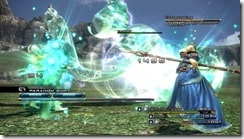Over the last couple of weeks, well actually before my exams week, I decided to give it a go on Final Fantasy XIII. It was always been a tough decision (well, not exactly) for me to play this game, since all the news that gives this incarnation of the game a bad name. Final Fantasy series has always been a good series, albeit with some differences between the games. And to tell the truth, I’m a bit sick of the oh-so-technological-world in their games.
But I decided to give it a go anyways, to see what Final Fantasy XIII would actually gives me as a player. A bit of an info though, I’m more leaned towards Japanese-type gamer, rather than Western-type gamer. This has been confirmed by some of my friends, as well as my tastes on selecting games. Most of the game that Japanese gamers think highly of, was not as successful in Western world, and vice versa. So here it is, after playing Final Fantasy for a week or so, what I think about the game. Bear with me in this long article!
Storyline
Most people play Final Fantasy series for one and one reason only: the story. Since the dawn of Final Fantasy VII, which is by far the best Final Fantasy ever created, not because the graphics, not because the music, and not because we don’t have any other RPG at that time. It was because the storyline. Although Final Fantasy, and most of the other RPG that I know of would then puts you as the main character in the position to save the world (even Harvest Moon makes you save the land), I noticed Final Fantasy XIII took a bit of the Suikoden approach.
In the world of Final Fantasy XIII, the world itself is divided into two, Cocoon and Gran Pulse. Cocoon itself is a kind of planet floating above Gran Pulse. Gran Pulse is the wilderness and a savage place, therefore people in Cocoon treats Pulse as hell, and vice versa. This conflict stems from godly beings called fal’Cie which exists in both worlds. fal’Cie is known to mark people, or rather, curse people to do their job. These marked people, known as l’Cie would have to finish their focus, the task given by the fal’Cie before the markings in their body is in the final stage. If that happens, they’ll be turned into mindless monsters. What’s worse, if they DO finish their focus, they’ll be turned into crystal.
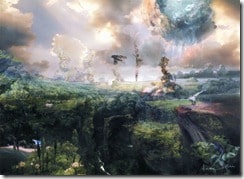
Now you probably can guess to this point where this leads us. The main characters are by luck (or rather, bad luck) is forced to be a l’Cie and complete their focus. Storywise, this kind of reminds me of Suikoden series. The story itself consists of many chapters, which I believe is around 13 chapters. However, as I’ve played to at least chapter 11 now, I still don’t know EXACTLY what their focus is.
The character development in pretty good. Because the way the game is played, in which everyone took a different paths in the first time and then converges around chapter 11 or so, everyone gets the chance to be developed and you get the chance to know their background. Some even change personalities in the course of the game.
I would give 8 out of 10 for the story. Reason being, it somewhat lacks originality, since the first time I played this I feel like I’ve had it enough with these seemingly odd names, and also it just feel like I’ve seen the storyline somewhere. Bear in mind that I did NOT follow the development of Final Fantasy XIII, so I was totally new to the story. Moreover, why did it get so damn long to gather all the characters at chapter 11 out of 13 chapters?
Gameplay
The game was notorious in Japan for a reason: a linear gameplay. Although all RPG games must have somewhat linearity in order for the story to advance, Final Fantasy XII took it to a whole new level, in a bad way. The dungeons now are pretty much a corridor, which you would always, and always find yourself walking towards the destination. There are some minor branches in the path, but that’s only for getting treasures and probably just took you few steps from the initial path. And as you might have guessed, there are no towns and cities, unless the game told you to go there, though.
In fact, the story is so linear that you only get one chance to explore the world in a non linear way, which is only available after chapter 11 in the game. Furthermore, because of the linearity, you have to battle the enemies along the path. You can avoid one or two enemies, but most of the time you’ll have to battle them, which I find slightly annoying.
The monsters roam the world, like in Final Fantasy XII, but if you initiate battle, you’ll be taken to a separate battle screen. I have to praise SquareEnix for having the battle screen load time very, very short. And talking about battle, Final Fantasy XIII in my opinion, has the most advanced yet most complicated battling method, which is good in my opinion.
There are no more attack-like-there-is-no-tomorrow type of battle. You HAVE to actually plan the battle. Now every character in battle (at most 3 characters) is given a role, which is called Paradigm. This role is comprised of six roles, a Commando (physical attacker), a Ravager (magical attacker), a Sentinel (essentially a defender), a Saboteur (status ailments attacker), a Synergist (status supporter) and a Medic (a healer). Every character has three major role and three minor role which will later be unlocked. Oh yeah, you can ONLY control the party leader at the battle, but the AI is pretty good to do what their roles told them to.
These roles creates a combination during the battle. You are encouraged to shift Paradigms during battle in order to cope with different enemies. Often, you have to stagger (in a sense, ‘break’ the enemy) in order to gain a boosted attack and finish the battle easier. These method, called Paradigm Shift, is crucial since the character can only do what their role can do. A Commando cannot heal, so either they have to change to Medic role, or someone with Medic role heal them, and the same is true for every role. This adds a bit of complexity in the battle system.
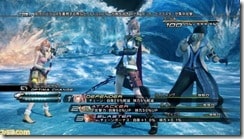
There are no level system in the game, which I find odd, but it goes well with the new system. Instead of having levels, characters are now developed through a Crystarium system, which is in essence, developing the roles that they have. A battle now gives you Crystarium Points instead of experience points like usual. These points will be used to develop the roles in the Crystarium.
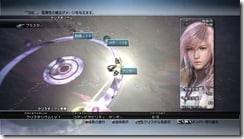
Major roles of a character generally cost less than the minor roles. Also, as I have mentioned before, a role can only access abilities that the current role has, but for the status parameters (such as health, attack, etc) is permanently attached to the character. I find this a good improvement, but makes it annoying since the game expect you to always develop the characters, otherwise you’ll be wiped out by the enemies.
There are still summons, which are called Eidolons in this game. Despite condemning every name changes of summon in every incarnations, they still fight alongside your character during battles if you summon them. They have a HP bar which depletes during the battle as well as when taking damage. But at the end you could always enter Gestalt Mode in where the summon would change form and your character can ride them. In Gestalt mode, you’re given a counter which depletes everytime you use an attack.
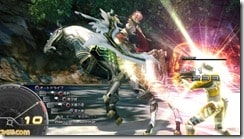
One last thing. They decided to remove the magic point system, which in my opinion is a good improvement. I’ve never been a fan of an MP system anyways. Every abilities now comes with an ATB cost, so the characters are forced to fill out the ATB gauge before they can start attacking. This actually goes well with the paradigm system, as it enforces you to plan the battle.
I would give 6 out of 10 for the gameplay. Reason being, the linearity of gameplay which forces you to fight enemies when you don’t have to. Also, late in the game, you’ll find that the enemies have become too strong for you, but you couldn’t turn back to retrain because of the linearity.
Audio
The latest Final Fantasy game did NOT include Nobuo Uematsu as the composer of the tracks. Boo for SquareEnix, but I heard he’s working on new projects (Kingdom Hearts III, presumably?), so I guess they’re forgiven. The sound that accompanies the game itself is more than decent, in my opinion. Every chapters (or more like, place) have their own theme, which I find a bit refreshing. Moreover, the theme suits the place as well, such as having an upbeat song when they’re at Nautilus, which is a bustling city with an amusement park.
However it gets annoying at mid game since the dungeon (more like corridor actually) is so damn long and the music just keeps repeating and repeating. You don’t feel the same way? I guess it’s just me then. The battle music is somewhat decent, not pretty much gives you oomph to do more battles, but it complements well with the overall battle pace. One thing that I miss though, the victory fanfare. I mean, they gave a chocobo theme but not a victory fanfare? Come on.
I would give 8 out of 10 for the audio. Reason being, well the music itself is like I said, more than decent, but not as great as previous incarnations.
Graphics
This is where Final Fantasy XIII kicks ass. The graphics are, well, astonishingly astounding, to put it in a simple way. Indeed, they made this game for PlayStation 3 in the first place, so they took full advantage for the HD capabilities of the console. I played this game using my HD monitor and damn, my eyes were in a treat. This is one of the most beautiful game in terms of graphics I’ve ever played. Not even Heavy Rain can compare to this one (for your info, Heavy Rain has a pretty damn good graphics as well).

The graphics are so polished you wouldn’t even know that you’re actually playing a game (well, you could, actually, since you’re holding a controller, but anyways…). The monsters are rendered in their respective sizes. The details are…well, detailed, as in nothing was left out. And when you get to chapter 11 when you first travel to Gran Pulse, you’ll appreciate the effort they put on graphics. It is stunningly astonishingly astoundingly jaw-dropping.
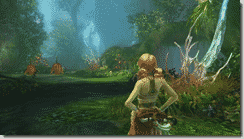
I would give the graphics 9.5 out of 10. Reason being, there is one slightly annoying bug. The movement of characters when they run, it just seems unnatural. If you look closely, it is as if they’re hopping in joy, not running.
Final Words
Adding up all the points until now, Final Fantasy XIII got around 31.5 out of 40 points, which in my opinion more than decent to be played. Sure there are some controversies around this game, particularly the seemingly apparent reason that it COULD break your PS3 and renders it useless, and the sales plummet to $5 each in Japan, but in my opinion, this game is both overrated and underrated by some.
There are some aspects of the game that I dislike, particularly the linearity and the lack of town, but in the end, the impressive graphics made up for it. Although this incarnation of the series is much criticised as not being a fully Final Fantasy game, I would say there’s more in this game than it meets the eye…literally.
jovee~
Images are courtesy of SquareEnix and Final Fantasy Wikia.

